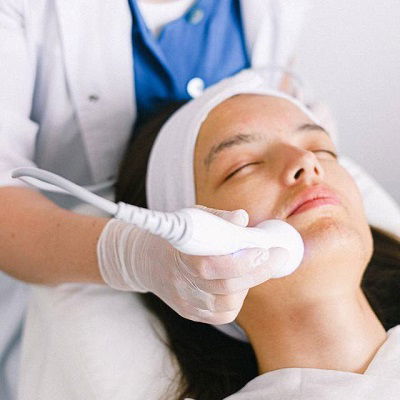HydraFacial vs. Microdermabrasion: Which is Better for Your Skin?
When it comes to skincare treatments, both HydraFacial and microdermabrasion are highly effective in improving skin texture, reducing signs of aging, and promoting a radiant complexion. If you're in search of the Best HydraFacial Treatment in Oman, understanding the differences between these two popular treatments will help you choose the right one for your skin needs. Let's dive into what makes each of these treatments unique and determine which might be more suitable for you.

What is HydraFacial?
HydraFacial is a non-invasive, multi-step facial treatment designed to cleanse, exfoliate, extract impurities, and hydrate the skin simultaneously. It uses a patented vortex technology to deliver serums tailored to your skin’s needs while vacuuming out dirt, oil, and dead skin cells. The procedure leaves your skin feeling refreshed, glowing, and deeply nourished.
How HydraFacial Works
HydraFacial works through a series of steps, including cleansing, exfoliating, extracting, and hydrating the skin. First, the skin is cleansed to remove surface impurities. Then, a gentle exfoliation is done using a special tip to slough off dead skin cells. The next step is extraction, where the device uses suction to remove blackheads and other clogged pores. Finally, the treatment ends with a nourishing hydration serum that restores moisture, leaving the skin plump and rejuvenated.
Benefits of HydraFacial
- Deep Hydration: The treatment helps to boost moisture levels in your skin, leaving it feeling soft and hydrated.
- Customized Treatment: Different serums are used to target specific skin concerns such as fine lines, acne, hyperpigmentation, or dullness.
- No Downtime: HydraFacial is a painless treatment with no recovery time, making it suitable for those with a busy lifestyle.
- Immediate Results: Most people see visible results after just one session, with glowing, smoother skin.
What is Microdermabrasion?
Microdermabrasion, on the other hand, is a physical exfoliation technique that uses tiny crystals or a diamond-tipped wand to slough off dead skin cells from the surface of the skin. This treatment focuses primarily on exfoliating and rejuvenating the outer layer of the skin, offering a more intense exfoliation compared to HydraFacial.
How Microdermabrasion Works
During a microdermabrasion session, the device sprays fine crystals onto the skin while simultaneously suctioning them away, along with dead skin cells. The process removes the outer layer of the epidermis, revealing fresher, smoother skin underneath. It's an excellent treatment for individuals who need a deeper exfoliation to improve skin texture.
Benefits of Microdermabrasion
- Improved Skin Texture: It effectively targets rough skin texture and uneven tone.
- Minimizes Fine Lines: Regular treatments can help reduce the appearance of fine lines and wrinkles.
- Acne Scarring Treatment: Microdermabrasion can help fade the appearance of acne scars and hyperpigmentation over time.
- Affordable: Compared to HydraFacial, microdermabrasion tends to be more budget-friendly.
Key Differences: HydraFacial vs. Microdermabrasion
While both HydraFacial and microdermabrasion are exfoliation techniques, there are several key differences that may influence your choice depending on your skin needs.
Skin Types and Concerns
- HydraFacial: This treatment is suitable for all skin types, including sensitive skin. It’s highly customizable, making it effective for a wide range of skin concerns, from dryness to acne.
- Microdermabrasion: While beneficial for many skin types, it may not be suitable for individuals with sensitive or rosacea-prone skin due to its more aggressive exfoliation process.
Hydration and Extraction
- HydraFacial: One of the standout features of HydraFacial is its hydrating elements. The treatment includes serums that nourish and hydrate the skin, leaving it plump and moisturized.
- Microdermabrasion: This treatment focuses on exfoliation and may leave the skin feeling slightly dry immediately after the session. Hydration may need to be applied afterward.
Treatment Duration and Downtime
- HydraFacial: Sessions typically take around 30 minutes, and there’s no downtime. You can resume your daily activities immediately.
- Microdermabrasion: Microdermabrasion usually takes a bit longer, depending on the size of the treatment area, and some people experience mild redness or sensitivity that may last for a few hours.
Which Treatment is Best for Your Skin?
Deciding between HydraFacial and microdermabrasion depends on your skin’s needs, your goals, and the time you’re willing to invest in the treatment.
For Immediate Glow and Hydration
If you're looking for a treatment that delivers an instant, glowing complexion with deep hydration, the Best HydraFacial Treatment in Oman is an excellent option. HydraFacial not only exfoliates but also nourishes and moisturizes the skin, leaving you with a radiant and refreshed appearance.
For Deep Exfoliation and Skin Texture Improvement
If your primary concern is improving skin texture and minimizing fine lines, microdermabrasion may be a better choice. The intense exfoliation can help smooth the skin and fade scars, though it may not provide the same level of hydration as HydraFacial.
Conclusion: HydraFacial vs. Microdermabrasion
Ultimately, both HydraFacial and microdermabrasion are effective skincare treatments, but they serve different purposes. HydraFacial is ideal for those seeking a comprehensive treatment that cleanses, exfoliates, and hydrates the skin, with minimal downtime and immediate results. On the other hand, microdermabrasion offers a deeper exfoliation and is best for those focused on improving skin texture and minimizing imperfections.
